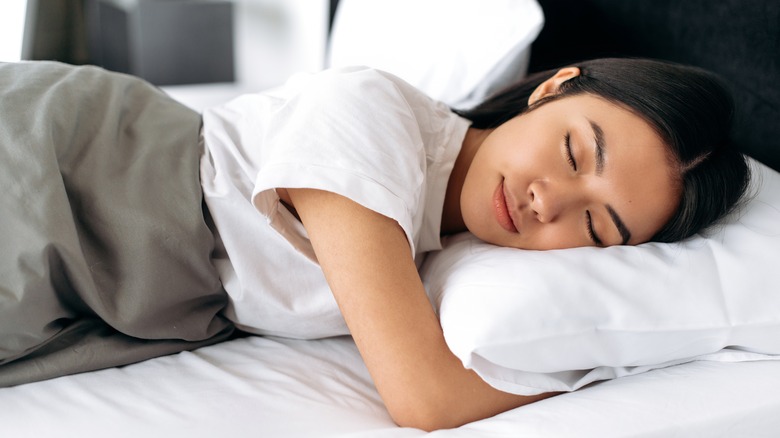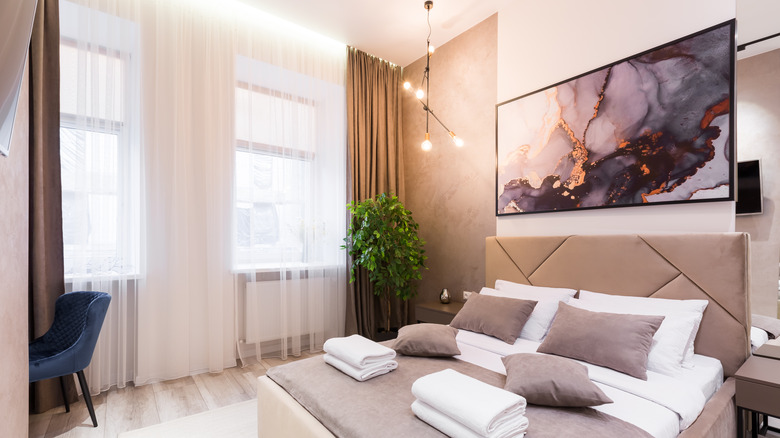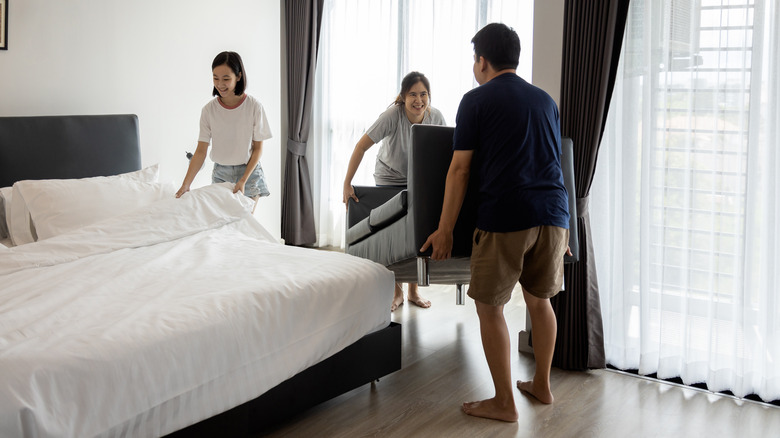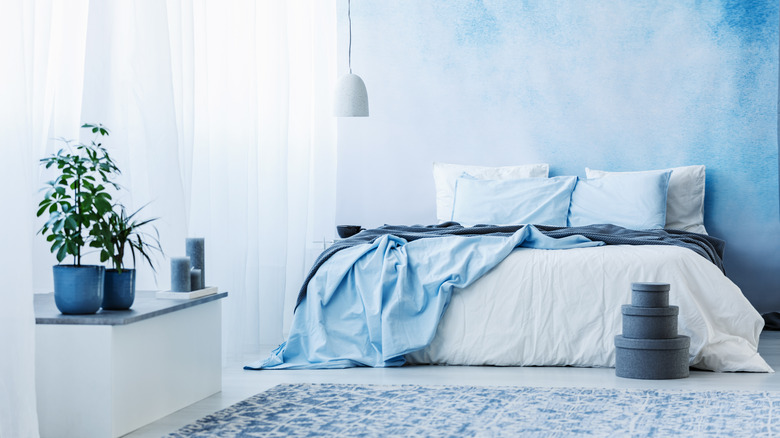Arranging Your Furniture A Certain Way May Help You Sleep Better
If you've been having trouble falling asleep lately, perhaps you've made some changes to your bedroom's design. Maybe you've invested in blackout curtains, thinking that the light from your window was keeping you awake. Or, perhaps you've added a noise machine to your side table to distract you from annoying noises outside. Popular Science suggests replacing your phone with an alarm clock, as this can help you limit your screen time before bed. Decluttering your room could also help you sleep more soundly.
However, while these ideas can definitely improve your quality of sleep, there's another important factor that many overlook: it's also very important how you arrange your bedroom furniture. Sleep Junkie surveyed 1,064 people to determine what bedroom layout was ideal for getting the best night's sleep, and 75% of people agreed on one distinct design. Below, you'll discover this layout, as well as why the way you arrange your bedroom furniture is important. You'll also find out some additional tips on arranging your furniture that will help you get the best sleep possible.
The best bedroom furniture arrangement
According to Sleep Junkie, 75% of people who said they slept soundly preferred the following layout: the bed up against a wall that doesn't have a window or a door, with the television positioned on the opposite wall. However, while this is the preferred arrangement, some may desire to make some minor tweaks. For instance, if you enjoy waking up to sunlight streaming into your bedroom, you may prefer placing your bed closer to the window or even against the window. You could also place your television in the farthest corner instead of flat against the opposite wall, if that's a better arrangement for your room's layout. Or, maybe you don't want a television in your bedroom at all, which could also improve your quality of sleep.
Apartment Guide gives some practical advice on arranging your furniture. They say to begin by deciding where your bed should be placed, since it's most likely the biggest piece. From there, you can move down the line from the next largest piece to the smallest. If you have a cramped room, you should only use furniture you really need, which will most likely include your bed, a dresser, and side tables. Also, make sure that you don't block any doors or walkways when arranging your furniture.
Why arranging your furniture a certain way is important
So, if the way you arrange your bedroom furniture potentially impacts the quality of your sleep, why is that the case? Hello Giggles points out that certain room designs can make us subconsciously feel more vulnerable to potential dangers. For instance, if your bed was placed in the center of the room, you may worry that someone will startle you from behind your headboard, which could keep you up at night. Or, if your bed is near the door or is perfectly aligned with the door, you may fear that someone may enter your room and harm you while you're sleeping. Additionally, if you can't see every corner of your room, this could cause you to fear that someone is hiding in the areas you cannot see. This is why placing your bed against the main wall, with the doors and windows on either side of you, may help you get the best sleep possible.
Home Zone also says that including certain pieces of furniture in your space can make you feel like you're in danger. For instance, you may fear that a large light fixture above your bed or a tall bookcase beside you may fall on you in the night. Keeping these items out of the bedroom may help you relax and get a better night's sleep.
Additional tips on designing your bedroom
If you're still having trouble falling asleep even after rearranging your furniture, there are some other factors you should consider that may be keeping you awake. The first is the color of your bedroom's walls. According to Sleep Junkie, those who reported sleeping the best had purple or blue paint on their walls. This makes sense because these cool-toned colors can promote relaxation. However, the Sleep Foundation says that softer and warmer tones may be the best choice, as they are also soothing. What really matters is choosing a color you enjoy that doesn't carry too much energy.
Something else to consider is where your bedroom itself is placed. Home Zone points out that bedrooms near the front door or those with many windows may have too much noise or light. Maybe you could consider moving your bedroom to your guest room or another extra space in your home that has fewer windows and is farther away from the front door. Additionally, consider the size of your room — larger areas may make you feel like there is a threat of danger or may cause you to feel less cozy.
Finally, Hello Giggles says that you shouldn't store lots of items underneath your bed, as this can give your room a chaotic energy. Keeping the space under your bed empty will provide betterair flow and give you more peace of mind.



